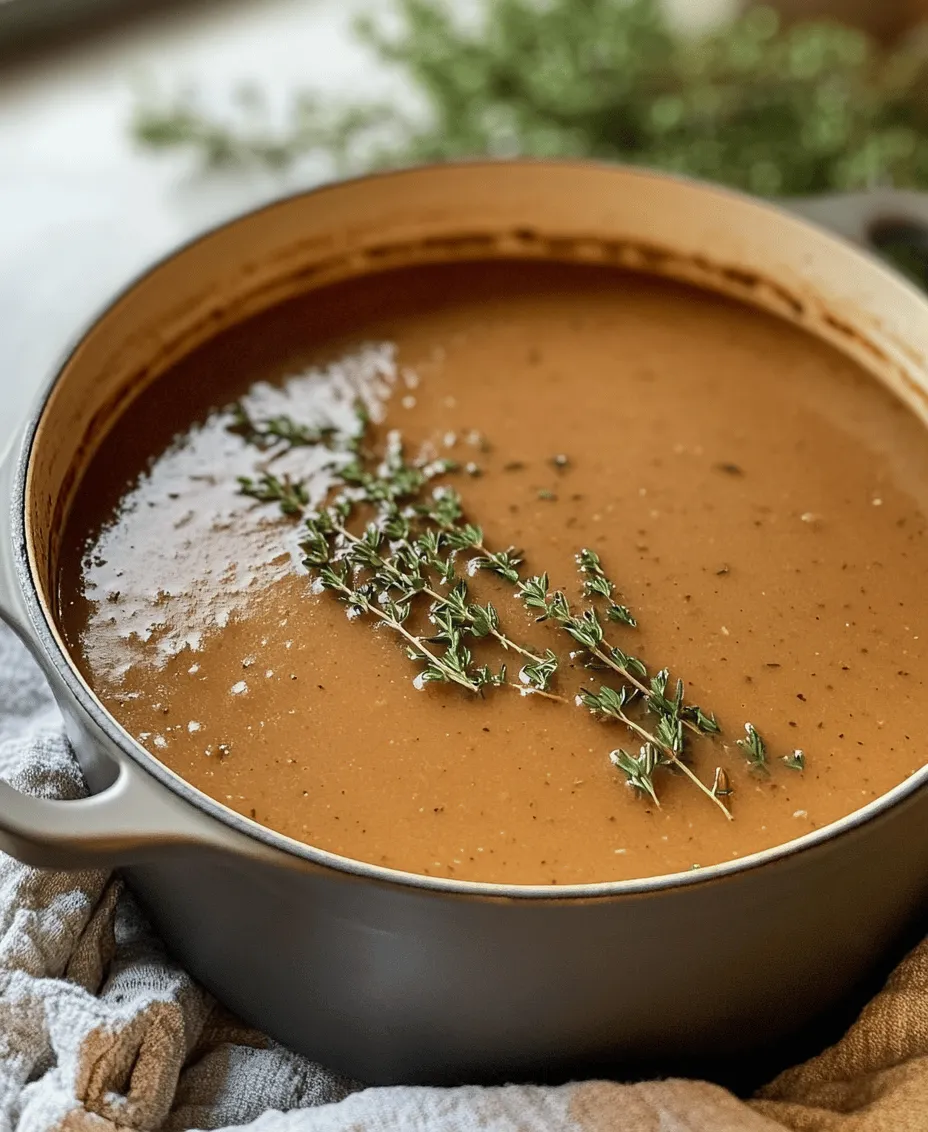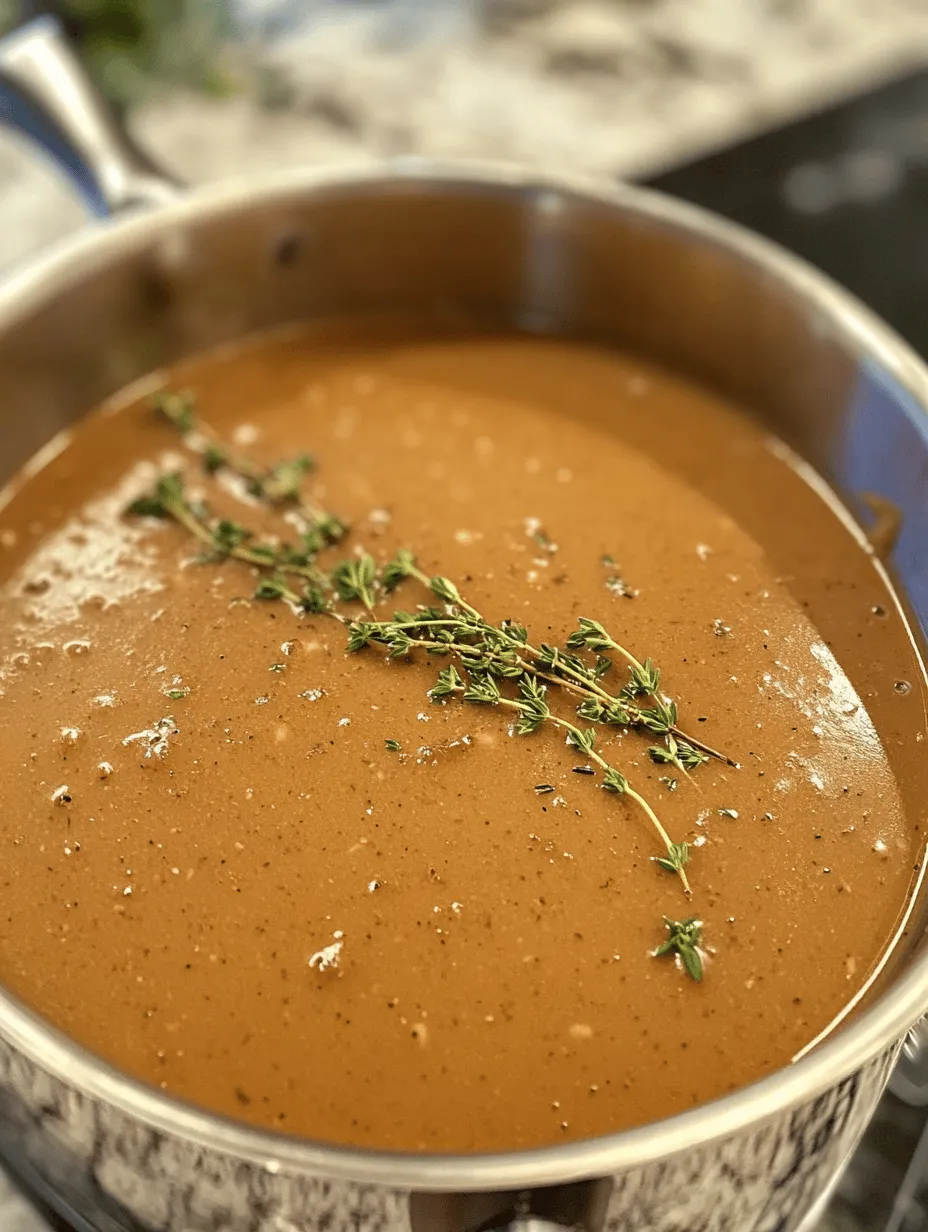Introduction
Gravy is often regarded as the unsung hero of many meals, particularly during the holiday season. It adds a rich, comforting element that not only enhances the flavor of turkey but also brings together various dishes on your dinner table. Whether you’re drizzling it over mashed potatoes, stuffing, or roasted vegetables, gravy is an essential component of a satisfying meal.
Today, we are excited to share our Quick & Savory Turkey Gravy recipe, a versatile and easy-to-make addition that can elevate any meal, not just during Thanksgiving. This recipe is a fantastic way to utilize leftover turkey drippings, allowing you to create a delicious gravy in a matter of minutes. With just a few simple pantry ingredients, you can transform your drippings into a flavorful sauce that everyone will love.
In this article, we will walk you through the importance of gravy, the basics of its preparation, and the ingredients needed for our Quick & Savory Turkey Gravy. Let’s dive deeper into what makes this recipe a staple in kitchens everywhere.
Understanding the Basics of Gravy
Gravy is a sauce made from the juices of cooked meat, often thickened with flour or cornstarch. Its primary role is to enhance the flavor of dishes, providing a moist and rich counterpart to dry or bland foods. Whether you’re enjoying a hearty roast or a simple weeknight chicken dish, gravy can take your meal to the next level.
There are several types of gravy, including turkey, chicken, and vegetarian options. Each type has its unique flavor profile and preparation method. Turkey gravy is typically made using the drippings from a roasted turkey, giving it a deep, savory taste that perfectly complements the meat. Chicken gravy, on the other hand, uses drippings from chicken or broth as its base. For those following a vegetarian diet, gravies can be made using vegetable stock and a variety of seasonings to achieve a similar texture and flavor.
One of the critical decisions when making gravy is whether to use drippings or butter as the base. Using drippings adds an unparalleled depth of flavor, as the remnants from a roasted turkey are packed with savory goodness. Butter can be used as a substitute, but it often requires additional seasoning to replicate the complex flavor that comes from drippings. For the best results, we recommend starting with drippings whenever possible.
Ingredients Breakdown
To create our Quick & Savory Turkey Gravy, you’ll need the following ingredients:
1. Turkey Drippings or Butter: The backbone of any good gravy. Turkey drippings provide a robust flavor, while butter offers a creamy consistency. If you have drippings from a roasted turkey, use them for the best flavor. If not, unsalted butter is a great alternative.
2. All-Purpose Flour: This ingredient is crucial for thickening the gravy. When combined with the drippings or butter, flour creates a roux, which forms the base of the gravy and helps achieve the desired consistency.
3. Broth: Low-sodium chicken or turkey broth serves as the liquid component of the gravy. Using low-sodium broth allows you to control the saltiness of the final dish and ensures that the natural flavors shine through.
4. Soy Sauce (optional): This ingredient adds depth and richness to the gravy. It can enhance the umami flavor, making the gravy even more savory. However, if you’re watching your sodium intake, you can omit this ingredient or use a low-sodium version.
5. Garlic and Onion Powder: These flavor enhancers are essential for adding a subtle aromatic quality to the gravy. They provide a background flavor that complements the turkey drippings beautifully.
6. Seasoning: Salt and pepper are necessary for balancing flavors. Adjust the seasoning to your taste, keeping in mind that the drippings and broth may already contain some salt.
7. Fresh Herbs: Adding fresh herbs like thyme or parsley at the end of cooking not only enhances the flavor but also adds a pop of color to your gravy, making it visually appealing.
Step-by-Step Instructions
Now that we have a clear understanding of the ingredients needed, let’s move on to the first step in our gravy-making process: collecting drippings.
Collecting Drippings
1. Roast Your Turkey: Begin by roasting your turkey according to your preferred recipe. As it cooks, the juices will accumulate at the bottom of the roasting pan.
2. Let It Rest: After roasting, allow the turkey to rest for at least 20-30 minutes. This resting period helps redistribute the juices throughout the meat, ensuring a moist turkey.
3. Gather Drippings: Once the turkey has rested, carefully remove it from the roasting pan. Pour the drippings from the pan into a heatproof measuring cup or bowl. Allow the drippings to settle for a few minutes; the fat will rise to the top.
4. Skim Off the Fat: Use a spoon or a fat separator to skim off some of the excess fat, leaving you with a concentrated flavorful liquid. If you don’t have enough drippings, you can supplement with butter for a balanced flavor.
5. Measure Your Drippings: You should have about 1 to 2 cups of turkey drippings to work with for your gravy. If you have less, just adjust the other liquids accordingly.
Now that we have collected our turkey drippings, we are ready to move on to the next steps in making our Quick & Savory Turkey Gravy. Stay tuned for the detailed instructions on how to transform those drippings into a rich, savory sauce that will elevate your holiday meal!

Collecting Turkey Drippings
The foundation of a rich and flavorful turkey gravy lies in the drippings collected from the turkey after roasting. These drippings are packed with flavor, making them an essential component of your gravy. To collect turkey drippings, follow these steps:
1. Prepare the Roasting Pan: After roasting your turkey, carefully remove it from the oven. Allow it to rest on a cutting board or platter. Place the roasting pan on the stovetop over medium heat. This will help loosen the drippings stuck to the pan.
2. Skim the Fat: Using a spoon or a fat separator, skim off the excess fat from the surface of the drippings. While some fat is necessary for flavor, too much will make your gravy greasy.
3. Strain the Drippings: Pour the remaining drippings through a fine-mesh strainer into a bowl or measuring cup to remove any solids. This step ensures a smooth gravy.
4. Alternative Methods: If you do not have any drippings available, you can still create a delicious turkey gravy. Use store-bought turkey or chicken broth as your base. For added flavor, sauté diced onions, garlic, and herbs in a bit of butter before adding the broth. You can also incorporate a bit of soy sauce or Worcestershire sauce to deepen the flavor profile.
Making the Roux
The roux is a key component in making a thick and velvety gravy. It is a mixture of equal parts fat and flour, cooked together to form a paste. Here’s how to make it:
1. Choose Your Fat: Use the fat you skimmed from the turkey drippings or butter if you’re starting with broth. For a healthier option, consider using olive oil or a combination of butter and oil.
2. Heat the Fat: In a saucepan over medium heat, add your fat (about 1/4 cup). Allow it to melt and heat until bubbling but not browned.
3. Add the Flour: Gradually whisk in an equal amount of all-purpose flour (about 1/4 cup). Constantly stir to prevent lumps from forming. Cook the roux for 2-3 minutes until it achieves a light golden color and a nutty aroma. This step is crucial as it removes the raw flour taste and adds depth to your gravy.
4. Importance of Roux: The roux acts as a thickening agent, creating a smooth and creamy texture for your gravy. A well-made roux ensures that the gravy doesn’t have a floury taste and helps to stabilize the sauce, preventing separation.
Adding the Broth
Now that your roux is ready, it’s time to incorporate the broth. This step is where the magic happens!
1. Gradually Add Broth: Slowly whisk in about 2 cups of your turkey drippings or broth into the roux. It’s crucial to add the liquid gradually to avoid lumps. Whisk continuously as you pour to ensure a smooth consistency.
2. Bring to a Simmer: Increase the heat to medium-high and bring the mixture to a simmer. As it heats, the gravy will begin to thicken. If you prefer a thicker gravy, continue to simmer for an additional 5-10 minutes, stirring frequently.
3. Ensure Lump-Free Gravy: If you notice any lumps forming, you can use an immersion blender to smooth out the gravy, or strain it through a fine-mesh sieve for a perfectly silky finish.
Flavoring the Gravy
Once your gravy has reached the desired consistency, it’s time to enhance the flavor.
1. Seasoning: Taste the gravy and season with salt and pepper. Depending on your preference, you can also add other spices, such as garlic powder, onion powder, or a pinch of cayenne for a subtle kick.
2. Balancing Flavors: To deepen the flavor, consider adding a splash of soy sauce or Worcestershire sauce. Fresh herbs like thyme, rosemary, or sage can also complement the turkey flavor beautifully. Start with a teaspoon of fresh herbs and adjust to your taste.
3. Acidity: A touch of acidity can brighten the gravy. A squeeze of lemon juice or a splash of white wine can make a big difference. Add these ingredients in small amounts, tasting as you go.
Serving Suggestions
Your Quick & Savory Turkey Gravy is now ready to serve! Here are some delightful ways to incorporate it into your meal:
1. With Roasted Turkey: Pour the gravy generously over sliced turkey breast or dark meat for a classic presentation. It enhances the flavors and keeps the meat moist.
2. Mashed Potatoes: Serve the gravy over creamy mashed potatoes. The combination is a holiday staple that everyone loves.
3. Stuffing: Drizzle the gravy over stuffing or dressing for added moisture and flavor. The savory notes will complement the dish perfectly.
4. Biscuits: For a comforting meal, serve the gravy over freshly baked biscuits. This Southern classic is sure to be a hit.
5. Vegetables: Don’t forget about vegetables! Pour gravy over roasted or steamed vegetables like green beans or Brussels sprouts for added richness.
Quick Tips for Perfect Gravy Every Time
Creating the perfect turkey gravy can seem daunting, but with a few tips, you can avoid common pitfalls:
1. Common Mistakes: Avoid adding too much flour at once, as it can create lumps. Always whisk continuously when adding liquid to the roux, and don’t rush the simmering process; this helps develop flavor.
2. Adjusting Thickness: If your gravy is too thick, whisk in a bit more broth or water until you reach your desired consistency. If it’s too thin, let it simmer longer to reduce and thicken.
3. Storage Tips: Leftover gravy can be stored in an airtight container in the refrigerator for up to four days or frozen for up to three months. When reheating, add a splash of broth or water to restore its consistency.
Nutritional Information
Homemade turkey gravy is not only delicious but can also be a nutritious addition to your meals:
– Calories: A serving of turkey gravy (about 1/4 cup) contains approximately 50-100 calories, depending on the ingredients used.
– Nutrients: Turkey gravy provides protein and essential vitamins and minerals, especially when made with drippings. It can be high in sodium, so adjust seasoning accordingly.
– Health Considerations: To make your gravy healthier, consider using whole wheat flour instead of all-purpose flour, and reduce the amount of fat used. You can also use low-sodium broth to control salt levels.
Conclusion
Making Quick & Savory Turkey Gravy is not only easy but also a rewarding process that enhances your holiday meals and everyday dinners. With the right technique and a few simple ingredients, you can create a delicious gravy that will impress your family and friends.
Incorporating this recipe into your culinary repertoire will not only elevate your holiday traditions but also add a touch of homemade comfort to your everyday meals. The joy of cooking and sharing homemade gravy with loved ones is an experience that brings everyone together. So, gather your ingredients, follow the steps, and enjoy the rich flavors of this delightful turkey gravy!

